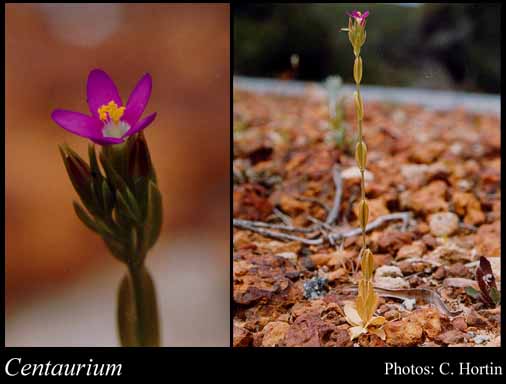- Reference
- Brit.Herb. 62 (1756)
- Name Status
- Current







Scientific Description
Common name. Centauries. Family Gentianaceae.
Habit and leaf form. Herbs. Plants unarmed; autotrophic. Annual, or biennial. Leaves basal, or cauline. Plants with a basal concentration of leaves, or with neither basal nor terminal concentrations of leaves. Young stems narrowly tetragonal (or multi-angled). To 0.1–0.5 m high. Helophytic, or mesophytic. Heterophyllous. Leaves small to medium-sized; not fasciculate; opposite; decussate; ‘herbaceous’; not imbricate; sessile; simple; not peltate; epulvinate. Leaf blades dorsiventral; entire; flat; obovate, or elliptic (and becoming narrower up the stem); pinnately veined, or parallel-veined; without cross-venules. Mature leaf blades adaxially glabrous; abaxially glabrous. Leaves without stipules (but the opposing leaf bases sometimes connected by a transverse line). Leaf blade margins entire; not prickly; flat. Leaf anatomy. Hairs absent.
Reproductive type, pollination. Fertile flowers hermaphrodite. Unisexual flowers absent. Plants hermaphrodite. Plants not viviparous; homostylous. Floral nectaries absent.
Inflorescence and flower features. Flowers solitary (rarely), or aggregated in ‘inflorescences’; not crowded at the stem bases; terminal. Inflorescence few-flowered to many-flowered. Flowers in cymes (sometimes resembling a corymb, spike or head). Inflorescences compound. The terminal inflorescence unit (when flowers aggregated) nearly always cymose. Inflorescences terminal, or axillary; ascending; usually a simple or compound dichasium; with involucral bracts. The fruiting inflorescence not conelike. Flowers pedicellate; ebracteate; small; odourless; regular; 5 merous, or 4 merous (rarely); tetracyclic. Free hypanthium absent. Hypogynous disk present. Perianth with distinct calyx and corolla; 8–10; 2 -whorled; isomerous. Calyx present; 5, or 4 (rarely); 1 -whorled; gamosepalous; lobed; lobulate. Calyx lobes about the same length as the tube, or markedly longer than the tube. Calyx glabrous; exceeded by the corolla; tubular; regular; neither appendaged nor spurred; non-accrescent. Calyx lobes narrowly linear. Corolla present; 4–5; 1 -whorled; gamopetalous; lobed; lobulate. Corolla lobes markedly shorter than the tube. Corolla tubular (salverform); regular; glabrous abaxially; glabrous adaxially; plain; pink, or purple, or yellow (C maritimum), or white (rarely); non-accrescent. Corolla lobes ovate. Androecial members definite in number. Androecium 4, or 5 (as many as the corolla lobes). Androecial members adnate (to the corolla tube); all equal; free of one another; 1 -whorled. Androecium exclusively of fertile stamens (commonly), or including staminodes. Staminodes 1–4 (occasionally representing all but one of the members). Stamens (1–)4–5; all more or less similar in shape; isomerous with the perianth, or reduced in number relative to the adjacent perianth (occasionally); all alternating with the corolla members. Filaments glabrous; filiform. Anthers all alike; basifixed; non-versatile; dehiscing via longitudinal slits. Gynoecium 2 carpelled. The pistil 1 celled. Carpels reduced in number relative to the perianth. Gynoecium syncarpous; synstylovarious; superior. Ovary unilocular; 1 locular. Ovary summit glabrous. Gynoecium stylate. Styles 1; apical; persistent; hairless. Stigmas 2; capitate (short and broad, caducous).
Fruit and seed features. Fruit not hairy; dehiscent; a capsule. Capsules septicidal. Dispersal unit the seed. Fruit 50 seeded. Seeds endospermic. Endosperm oily. Cotyledons 2.
Geography, cytology, number of species. World distribution: cosmopolitan. Native of Australia and adventive. Endemic to Australia. Australian states and territories: Western Australia, South Australia, Northern Territory, Queensland, New South Wales, Victoria, Australian Capital Territory, and Tasmania. Northern Botanical Province, Eremaean Botanical Province, and South-West Botanical Province. 2n = 20, 22, 36, 40. A genus of 40–50 species; 4 species in Western Australia.
Etymology. Names used by Pliny for various plants generally called centaury in English.
Taxonomic Literature
- Wheeler, Judy; Marchant, Neville; Lewington, Margaret; Graham, Lorraine 2002. Flora of the south west, Bunbury, Augusta, Denmark. Volume 2, dicotyledons. Australian Biological Resources Study.. Canberra..
- Australian Biological Resources Study 1996. Flora of Australia. Volume 28, Gentianales. CSIRO.. Melbourne..